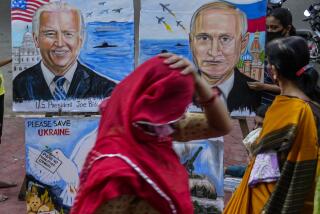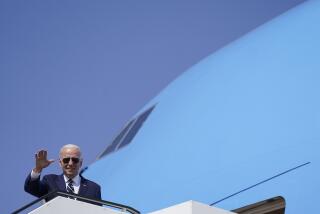Before His Visit, Clinton Rethinking U.S.-India Relations
WASHINGTON — President Bill Clinton has announced he will seek to defuse the increasingly explosive Kashmir conflict during his visit to South Asia later this month. This is a quixotic, last-minute attempt to impose a quick fix in a critical region that Clinton has alternately neglected and mishandled. If he wants peacemaking in Kashmir to be part of his legacy, he should first prepare the ground by using his visit to reverse the current disastrous course of U.S. policy toward New Delhi and Islamabad.
No effective U.S. mediation in South Asia will be possible until the United States removes the tensions and distrust that trouble its relations with India, an emerging power eight times bigger than Pakistan. These tensions, rooted in Washington’s Cold War tilt toward Islamabad, have been exacerbated by the economic sanctions imposed against New Delhi following its 1998 nuclear test. Clinton should use his visit to India to phase out sanctions; signal U.S. acceptance of Indian membership in the nuclear club; and convey a long-overdue U.S. recognition that India’s growing economic and military strength make it a major factor in the emerging Asian balance of power.
No effective U.S. mediation will be possible until an elected civilian government replaces the current military regime in Pakistan. Dominated by Islamic fundamentalist elements, the Islamabad junta is committed to keeping the Kashmir pot boiling. Instead of continuing to coddle the military regime, the United States should make clear it will oppose further multilateral aid until a timetable for an early return to civilian rule is announced.
As long as the armed forces retain absolute control, Islamic extremists will have far greater power than they have ever had before in Pakistan and will be free to act with impunity--as they did in the recent hijacking of an Indian airliner. For the ruling military triumvirate is controlled by two powerful generals with long-standing ties to fundamentalist groups: Lt. Gen. Mohammed Aziz, chief of the general staff, and Lt. Gen. Mahmoud Ahmed, director of interservices intelligence.
Aziz was the architect of the Pakistani invasion of Kashmir at Kargil in May 1999. India blames him not only for Kargil and the hijacking but also for a continuing increase in Pakistani support for the Kashmir insurgency. Not surprisingly, India believes that indefinite military rule will lead to multiplying Pakistani provocations. In both New Delhi and Islamabad, a war psychology is growing, and the danger of a fourth Indo-Pakistan war is greater now than at any time since the last one in 1971.
When the generals took over last October, the United States made no effort to pin them down to a timetable for a return to civilian rule because it hoped they would impose bold reforms to forestall an economic collapse. In December, Washington agreed to reschedule $950 million in Pakistani debts to the U.S. But on key reforms, such as tax collection, the triumvirate has dithered. The economic situation continues to deteriorate, and the regime is silencing potential critics.
It would be a grave mistake for Clinton to legitimize the junta by visiting Islamabad. Whatever he might say there, the generals would depict such a visit as acceptance of their rule and a vindication of Islamic extremism.
Past military regimes in Islamabad have not only become just as corrupt as civilian governments but have invariably fanned tensions with India to hold onto power. The few limited breakthroughs made in Indo-Pakistan relations came under civilian rule. Though the ousted civilian prime minister, Nawaz Sharif, was clearly corrupt, he did seek to improve relations with India at the Lahore summit of February 1999. Seeking to derail the nascent peace process, Army hard-liners, led by Aziz, staged the Kargil invasion three months later. Sharif’s decision to call off that invasion outraged the hard-liners, prompting the power struggle that culminated in the October coup.
Even under civilian rule, the road back to Lahore would be rocky, but the outlines of a possible Kashmir settlement are becoming visible. The cornerstone of such a settlement would be mutual Indian and Pakistani recognition of the existing cease-fire line in Kashmir as the permanent international boundary. This would be accompanied by the termination of Pakistani support for the insurgency in the Indian-held Kashmir Valley and the gradual reduction of forces both sides now deploy in Kashmir. But such a settlement would not be possible until India and Pakistan negotiate autonomy agreements with the Kashmiris under their control.
India, in particular, would have to show a new sensitivity to Kashmiri aspirations to soften the bitterness left by its brutal repression of the insurgency. As the war drags on, sentiment appears to be growing for a loose link to India as the only realistic way to end the bloodshed, but only if New Delhi will grant enough autonomy.
Until recently, hard-line Hindu forces in India have resisted proposals that would give its only Muslim-majority state autonomous status not enjoyed by other states. But support is now building for an overall restructuring of the Indian federal system in which Kashmir could get greater autonomy along with other states.
Clinton could help to pave the way for an eventual settlement by publicly declaring U.S. support for the cease-fire line in Kashmir as the permanent international boundary. Privately, he should urge India to move toward autonomy. But the focus of his visit to New Delhi should be on resolving nuclear tensions and encouraging Indo-U.S. economic cooperation.
In Indian eyes, the U.S. policy of seeking to roll back India’s nuclear program symbolizes a broader opposition to Indian progress toward major-power status that contrasts with U.S. solicitude toward China. This policy embitters Indo-U.S. relations, strengthening hard-liners who want to develop a muscular nuclear capability extending to intercontinental ballistic missiles.
The United States has conducted 949 nuclear tests and maintains an arsenal of 10,000 nuclear weapons. India and Pakistan alike regard the U.S. imposition of economic sanctions to punish them for several nuclear tests as hypocritical and arrogant.
In addition to removing sanctions, Clinton could signify U.S. acceptance of India’s new status as a nuclear power by relaxing restrictions on the sale of civilian nuclear technology in return for a formal Indian commitment barring export of its nuclear technology. The United States has already relaxed such restrictions to China. With its energy needs burgeoning, India is eager to augment its civilian nuclear-power program with U.S. reactors to offset its dependence on coal and oil.
The ban on civilian nuclear sales is only one of many U.S. restrictions blocking the transfer of any technology with a possible application to Indian nuclear or missile programs. These prohibitions conflict with the U.S. interest in expanding trade and investment links with New Delhi. India’s economic-growth rate is now nearing 7%, its foreign-exchange reserves are approaching $40 billion and its market-friendly economic reforms are gaining momentum. The World Bank, projecting a 9% economic-growth rate by 2006, predicts India will be the world’s fourth-largest economy by 2020, surpassed only by China, the United States and Japan.
It is primarily economics that explains why Clinton is visiting Bangladesh. Unocal, the U.S. oil company, wants to develop its rich natural-gas deposits and sell the gas to India if financial support can be found for a pipeline. Bangladesh now has a growth rate of 5% and booming exports. Continued economic progress with U.S. support would stabilize the parliamentary institutions now being consolidated there.
A new U.S. approach to South Asia attuned to post-Cold War realities would give comparable weight to Bangladesh (with a population of 130 million) and Pakistan (135 million) within the larger framework of a policy centered on India (975 million). One out of every five people in the world lives in South Asia. The mere fact of Clinton’s visit, the first by a U.S. president since 1979, will be a significant part of his legacy and will hopefully set the stage for more serious interest by his successors in this key region, an inexplicable blind spot for too long on the U.S. geopolitical horizon.
More to Read
Sign up for Essential California
The most important California stories and recommendations in your inbox every morning.
You may occasionally receive promotional content from the Los Angeles Times.










